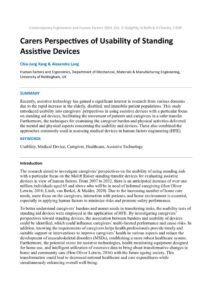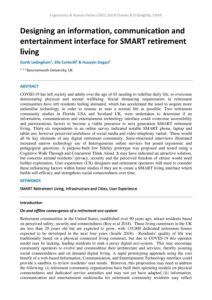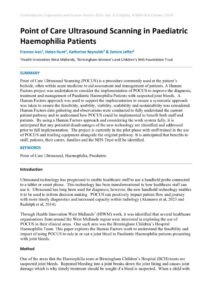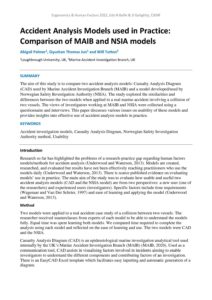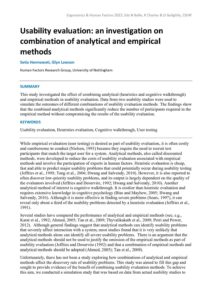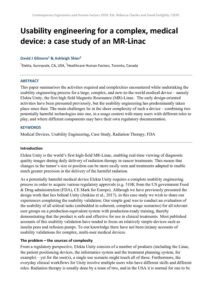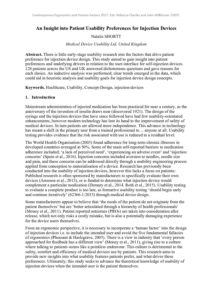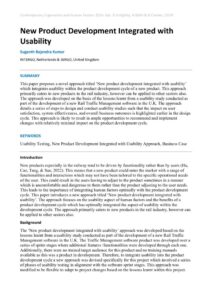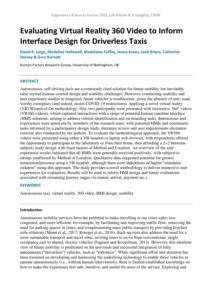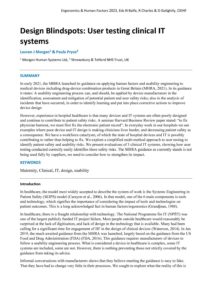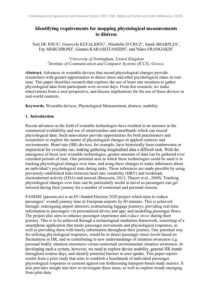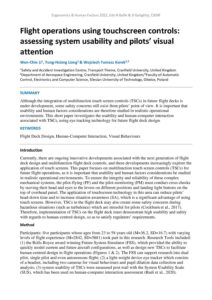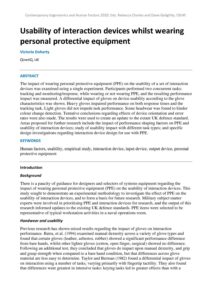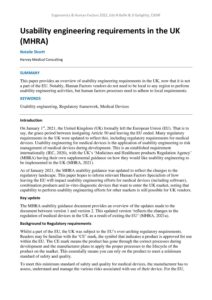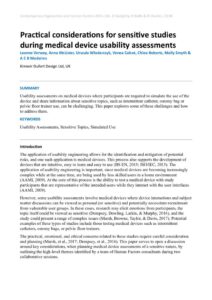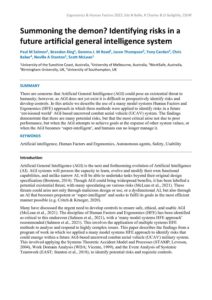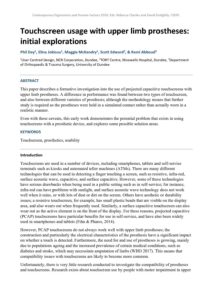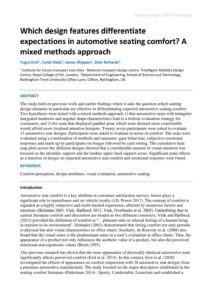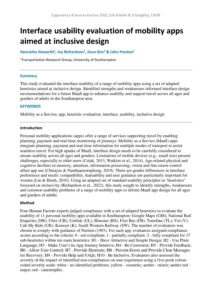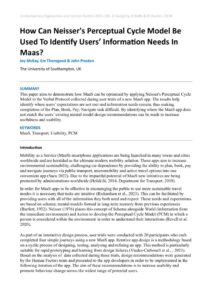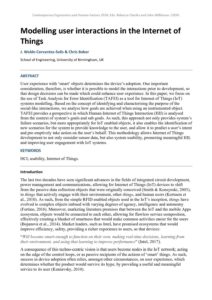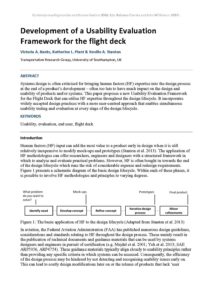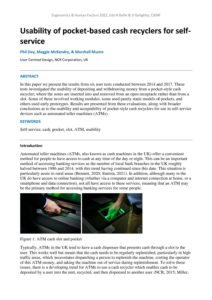Usability
A quick history lesson: Lean UX research at Hampton Court Palace
| Document | Author Pete UNDERWOOD |
| Abstract This paper describes the Lean UX research approach used to evaluate the Digital Visitors Guide (DVG) developed for use at Hampton Court Palace. The DVG was tested onsite at the palace over several rounds of research. The DVG was liked by participants, who felt that it was easy to use, engaging, modern and improved their learning experience. Taking a Lean UX approach worked well as insights were delivered, and design recommendations prioritised, efficiently in a collaborative environment. |
Carers Perspectives of Usability of Standing Assistive Devices
| Document | Author Chia-Jung Kang & Alexandra Lang |
| Abstract Recently, assistive technology has gained a significant interest in research from various domains due to the rapid increase in the elderly, disabled, and immobile patient populations. This study introduced usability into caregivers’ perspectives in using assistive devices with a particular focus on standing aid devices, facilitating the movement of patients and caregivers in a safer transfer. Furthermore, the techniques for examining the caregiver burden and physical activities delivered the mental and physical aspects concerning the usability and devices. These also combined the approaches commonly used in assessing medical devices in human factors engineering (HFE). |
Designing an information, communication and entertainment interface for SMART retirement living
| Document | Author Garth Ledingham, Ella Cotterill & Huseyin Dogan |
| Abstract COVID-19 has left society and adults over the age of 65 needing to redefine daily life, to overcome deteriorating physical and mental wellbeing. Social distancing requirements in retirement communities have left residents feeling alienated, which has accelerated the need to acquire more unfamiliar technology in order to resume as near a normal life as possible. Two retirement community studies in Florida USA and Scotland UK, were undertaken to determine if an information, communication and entertainment technology interface could overcome accessibility and parsimonious factors to become a viable precursor to next generation SMART retirement living. Thirty-six respondents in an online survey indicated notable SMART phone, laptop and tablet use; however perceived usefulness of social media and video telephony varied. These would all be key elements of any digital retirement community. Semi-structured interviews illustrated increased narrow technology use of heterogeneous online services but posed ergonomic and pedagogical questions. A purpose-built low fidelity prototype was proposed and tested using a Cognitive Walk Through and Concurrent Think Aloud. It may have indicated an attractive solution, but concerns around residents’ privacy, security and the perceived freedom of choice would need further exploration. User experience (UX) designers and retirement operators will need to consider these influencing factors within future studies if they are to create a SMART living interface which builds self-efficacy and strengthens social connectedness over time. |
Point of Care Ultrasound Scanning in Paediatric Haemophilia Patients
| Document | Author Frances Ives, Helen Hunt, Katherine Reynolds & Zamira Jaffer |
| Abstract Point of Care Ultrasound Scanning (POCUS) is a procedure commonly used at the patient’s bedside, often within acute medicine to aid assessment and management of patients. A Human Factors project was undertaken to consider the implementation of POCUS to improve the diagnosis, treatment and management of Paediatric Haemophilia Patients with suspected joint bleeds. A Human Factors approach was used to support the implementation to ensure a systematic approach was taken to ensure the feasibility, usability, viability, scalability and sustainability was considered. Human Factors data gathering and observations were conducted to fully understand the current patient pathway and to understand how POCUS could be implemented to benefit both staff and patients. By using a Human Factors approach and considering the work system fully, it is anticipated that any potential disadvantages of the new technology are identified and addressed prior to full implementation. The project is currently in the pilot phase with staff trained in the use of POCUS and trialling equipment alongside the original pathway. It is anticipated that benefits to staff, patients, their carers, families and the NHS Trust will be identified. |
Accident Analysis Models used in Practice: Comparison of MAIB and NSIA models
| Document | Author Abigail Palmer, Gyuchan Thomas Jun & Will Tutton |
| Abstract The aim of this study is to compare two accident analysis models: Casualty Analysis Diagram (CAD) used by Marine Accident Investigation Branch (MAIB) and a model developed/used by Norwegian Safety Investigation Authority (NSIA). The study explored the similarities and differences between the two models when applied to a real marine accident involving a collision of two vessels. The views of investigators working at MAIB and NSIA were collected using a questionnaire and interviews. This paper discusses various issues on usability of these models and provides insights into effective use of accident analysis models in practice. |
Usability evaluation: an investigation on combination of analytical and empirical methods
| Document | Author Setia Hermawati & Glyn Lawson |
| Abstract This study investigated the effect of combining analytical (heuristics and cognitive walkthrough) and empirical methods in usability evaluation. Data from two usability studies were used to simulate the outcomes of different combinations of usability evaluation methods. The findings show that the combined analytical methods significantly reduce the number of participants required in the empirical method without compromising the results of the usability evaluation. |
Usability engineering for a complex, medical device: a case study of an MR-Linac
| Document | Author David J Gilmore & Ashleigh Shier |
| Abstract This paper summarises the activities required and complexities encountered while undertaking the usability engineering process for a large, complex, and new-to-the-world medical device – namely Elekta Unity, the first high field Magnetic Resonance (MR)-Linac. The early design-oriented activities have been presented previously, but the usability engineering has predominantly taken place since then. The main challenges lie in the sheer complexity of such a device – combining two potentially harmful technologies into one, in a usage context with many users with different roles to play, and where different components may have their own regulatory documentation. |
Software analysis of racing drivers’ interfaces using Link Analysis and Fitts’ Law
| Document | Author James W H Brown, Neville A Stanton & Kirsten M A Revell |
| Abstract This paper discusses the development, application, and proof-of-concept test of software designed to analyse specific aspects relating to the usability of steering wheel-based interfaces in racing cars. A combination of link analysis and Fitts’ Law is employed in order to identify interface efficiency and potential driver physical workload. The racing driver’s primary goal is to win races, this is achieved through a combination of primary and secondary tasks. These sometimes-complex secondary tasks can however overload the driver and cause distraction, leading to driving errors with potentially serious consequences. Equally, drivers experiencing high primary task workload may be more prone to making interface-based errors, particularly when complex secondary tasks are performed. Steering wheel-based interfaces were analysed from four 2017 Formula One season cars, measurements were taken, and control coordinates, dimensions, and control types recorded. A set of typical secondary interactions involving interface controls common to all the cars that might take place within the first ten laps of a race were derived from on-board footage. A software application was developed to load this control layout and interaction data, and carry out link analysis, Fitts’ Law and hybrid calculations. The analysis revealed a range of data, including traversal distances and indices of difficulty for activating individual controls or combinations. This provides insight into efficiency and physical workload levels associated with interface designs. Designs can then by optimised and retested by updating the control layout data, or with variations of interaction data, with the ultimate goal of reducing errors as well as improving safety and driver performance. |
An Insight into Patient Usability Preferences for Injection Devices
| Document | Author Natalie SHORTT |
| Abstract There is little early-stage usability research into the factors that drive patient preference for injection device design. This study aimed to gain insight into patient preferences and underlying drivers in relation to the user-interface for self-injection devices. 128 patients across the US and UK answered dichotomous questions and gave reasons for each choice. An inductive analysis was performed; clear trends emerged in the data, which could aid in heuristic analysis and usability goals for injection device design concepts. |
New Product Development Integrated with Usability
| Document | Author Suganth Rajendra Kumar |
| Abstract This paper proposes a novel approach titled ‘New product development integrated with usability’ which integrates usability within the product development cycle of a new product. This approach primarily caters to new products in the rail industry, however can be applied to other sectors also. The approach was developed on the basis of the lessons learnt from a usability study conducted as part of the development of a new Rail Traffic Management software in the U.K. The approach details a series of steps to design and conduct usability studies such that the impact on user satisfaction, system effectiveness, and overall business outcomes is highlighted earlier in the design cycle. This approach is likely to result in ample opportunities to recommend and implement changes with relatively minimal impact on the product development cycle. |
Evaluating Virtual Reality 360 Video to Inform Interface Design for Driverless Taxis
| Document | Author David R. Large, Madeline Hallewell, Madelaine Coffey, Jenna Evans, Leah Briars, Catherine Harvey & Gary Burnett |
| Abstract Autonomous, self-driving taxis are a commonly cited solution for future mobility but inevitably raise myriad human-centred design and usability challenges. However, conducting usability and user experience studies in imagined, future vehicles is troublesome, given the absence of safe, road-worthy exemplars (and indeed, recent COVID-19 restrictions). Applying a novel virtual reality (VR) Wizard-of Oz methodology, fifty-two participants were presented with immersive 360° videos (VR360-videos), which captured interactions with a range of potential human-machine interface (HMI) solutions, aiming to address vehicle identification and on-boarding tasks. Interactions and experiences were acted out by members of the research team, with potential HMIs and constituent tasks informed by a participatory design study, literature review and user requirements elicitation exercise also conducted by the authors. To evaluate the methodological approach, the VR360-videos were presented using either a VR-headset or laptop web-browser, with respondents offered the opportunity to participate in the laboratory or from their home, thus affording a 2×2 between-subjects study design with fixed factors of Method and Location. An overview of the user experience results indicated that all HMIs were generally received positively, with subjective ratings unaffected by Method or Location. Qualitative data suggested potential for greater immersion/presence using a VR-headset, although there were indications of higher “simulator sickness” using this approach. The study provides a novel methodology to deliver immersive user experiences for evaluation. Results will be used to inform HMI design and future evaluations associated with remaining journey stages (in-transit, arrival, payment etc.). |
Design Blindspots: User testing clinical IT systems
| Document | Author Lauren J Morgan & Paula Pryce |
| Abstract In early 2021, the MHRA launched its guidance on applying human factors and usability engineering to medical devices including drug-device combination products in Great Britain (MHRA, 2021). In its guidance it states: A usability engineering process can, and should, be applied by device manufacturers in the identification, assessment and mitigation of potential patient and user safety risks; also in the analysis of incidents that have occurred, in order to identify learning and put into place corrective actions to improve device design However, experience in hospital healthcare is that many devices and IT systems are often poorly designed and continue to contribute to patient safety risks. A seminar Harvard Business Review paper stated: “to fix physician burnout, we must first fix the electronic patient record”. In everyday work in our hospitals we see examples where poor device and IT design is making clinicians lives harder, and decreasing patient safety as a consequence. We have a workforce cataclysm, of which the state of hospital devices and IT is possibly contributing to rather than helping to fix. We explore a simplified multi-method approach to user testing to identify patient safety and usability risks. We present evaluations of 3 clinical IT systems, showing how user testing conducted correctly easily identifies these safety risks. The MHRA guidance as currently stands is not being used fully by suppliers, we need to consider how to strengthen its impact. |
Identifying requirements for mapping physiological measurements to distress
| Document | Author Neil DE JOUX, Genovefa KEFALIDOU, Mirabelle D’CRUZ, Sarah SHARPLES, Fay MISICHRONI, Giannis KARASEITANIDIS, and Nikos FRANGAKIS |
| Abstract Advances in wearable devices that record physiological changes provide researchers with greater opportunities to detect stress and other psychological states in real-time. This paper describes research that explores the use of heart rate monitors to gather physiological data from participants over several days. From this research, we make observations from a user perspective, and discuss implications for the use of these devices in real-world contexts. |
Flight operations using touchscreen controls: assessing system usability and pilots’ visual attention
| Document | Author Wen-Chin Li, Yung-Hsiang Liang & Wojciech Tomasz Korek |
| Abstract Although the integration of multifunction touch screen controls (TSCs) in future flight decks is under development, some safety concerns still exist from pilots’ point of view. It is important that usability and human factors considerations are therefore studied in realistic operational environments. This short paper investigates the usability and human-computer interaction associated with TSCs, using eye tracking technology for future flight deck design. |
Usability of interaction devices whilst wearing personal protective equipment
| Document | Author Victoria Doherty |
| Abstract The impact of wearing personal protective equipment (PPE) on the usability of a set of interaction devices was examined using a single experiment. Participants performed two concurrent tasks: tracking and monitoring/response, while wearing or not wearing PPE, and the resulting performance impact was measured. A differential impact of gloves on device usability according to the glove characteristics was shown. Heavy gloves impaired performance on both response times and the tracking task. Light gloves did not impede task performance. Some headwear was found to hinder colour change detection. Tentative conclusions regarding effects of device orientation and error rates were also made. The results were used to create an update to the extant UK defence standard. Areas proposed for further research include the impact of performance shaping factors on PPE and usability of interaction devices; study of usability impact with different task types; and specific design investigations regarding interaction device design for use with PPE. |
Usability engineering requirements in the UK (MHRA)
| Document | Author Natalie Shortt |
| Abstract This paper provides an overview of usability engineering requirements in the UK, now that it is not a part of the EU. Notably, Human Factors vendors do not need to be local to any region to perform usability engineering activities, but human factors processes need to adhere to local requirements. |
Practical considerations for sensitive studies during medical device usability assessments
| Document | Author Leanne Verwey, Anna McLister, Urszula Wlodarczyk, Venea Calcot, Chloe Roberts, Molly Smyth & A C B Medeiros |
| Abstract Usability assessments on medical devices where participants are required to simulate the use of the device and share information about sensitive topics, such as intermittent catheter, ostomy bag or pelvic floor trainer use, can be challenging. This paper explores some of these challenges and how to address them. |
Summoning the demon? Identifying risks in a future artificial general intelligence system
| Document | Author Paul M Salmon, Brandon King, Gemma J. M Read, Jason Thompson, Tony Carden, Chris Baber, Neville A Stanton & Scott McLean |
| Abstract There are concerns that Artificial General Intelligence (AGI) could pose an existential threat to humanity; however, as AGI does not yet exist it is difficult to prospectively identify risks and develop controls. In this article we describe the use of a many model systems Human Factors and Ergonomics (HFE) approach in which three methods were applied to identify risks in a future ‘envisioned world’ AGI-based uncrewed combat aerial vehicle (UCAV) system. The findings demonstrate that there are many potential risks, but that the most critical arise not due to poor performance, but when the AGI attempts to achieve goals at the expense of other system values, or when the AGI becomes ‘super-intelligent’, and humans can no longer manage it. |
Touchscreen usage with upper limb prostheses: initial explorations
| Document | Author Phil Day, Elina Jokisuu, Maggie McKendry, Scott Edward, & Rami Abboud |
| Abstract This paper describes a formative investigation into the use of projected capacitive touchscreens with upper limb prostheses. A difference in performance was found between two types of touchscreen, and also between different varieties of prosthesis; although the methodology means that further study is required as the prostheses were held in a simulated contact rather than actually worn in a realistic manner. Even with these caveats, this early work demonstrates the potential problem that exists in using touchscreens with a prosthetic device, and explores some possible solution areas. |
Which design features differentiate expectations in automotive seating comfort? A mixed methods approach
Interface usability evaluation of mobility apps aimed at inclusive design
| Document | Author Henrietta Howarth, Joy Richardson, Jisun Kim & John Preston |
| Abstract This study evaluated the interface usability of a range of mobility apps using a set of adapted heuristics aimed at inclusive design. Identified strengths and weaknesses informed interface design recommendations for a future MaaS app to enhance usability and support travel across all ages and genders of adults in the Southampton area. |
How Can Neisser’s Perceptual Cycle Model Be Used To Identify Users’ Information Needs In Maas?
| Document | Author Joy McKay, Em Thorogood & John Preston |
| Abstract This paper aims to demonstrate how MaaS can be optimised by applying Neisser's Perceptual Cycle Model to the Verbal Protocol collected during user trials of a new MaaS app. The results help identify where users’ expectations are not met and information needs remain, thus making completion of the Plan, Book, Pay, Navigate task difficult. By identifying where the MaaS app does not match the users’ existing mental model design recommendations can be made to increase usefulness and usability. |
Modelling user interactions in the Internet of Things
| Document | Author J. Waldo Cervantes-Solis & Chris Baber |
| Abstract User experience with ‘smart’ objects determines the device’s adoption. One important consideration, therefore, is whether it is possible to model the interactions prior to development, so that design decisions can be made which could enhance user experience. In this paper, we focus on the use of Task Analysis for Error Identification (TAFEI) as a tool for Internet of Things (IoT) systems modelling. Based on the concept of identifying and characterising the purpose of the social-like interactions, we analyse how goals are achieved when using an instrumented object. TAFEI provides a perspective in which Human-Internet of Things Interaction (HII) is analysed from the context of system’s goals and sub goals. As such, this approach not only provides system’s failure scenarios, but more appropriately for IoT enabled objects, it also enables the identification of new scenarios for the system to provide knowledge to the user, and allow it to predict a user’s intent and pre-emptively take action on the user’s behalf. This methodology allows Internet of Things development to not only consider sensor data, but also system usability, promoting meaningful HII, and improving user engagement with IoT systems. |
Development of a Usability Evaluation Framework for the flight deck
| Document | Author Victoria A. Banks, Katherine L. Plant & Neville A. Stanton |
| Abstract Systems design is often criticised for bringing human factors (HF) expertise into the design process at the end of a product’s development – often too late to have much impact on the design and usability of products and/or systems. This paper proposes a new Usability Evaluation Framework for the Flight Deck that can utilise HF expertise throughout the design lifecycle. It incorporates widely accepted design practices with a more user-centred approach that enables simultaneous usability testing and evaluation at every stage of the design lifecycle. |
Usability of pocket-based cash recyclers for self-service
| Document | Author Phil Day, Maggie McKendry & Marshall Munro |
| Abstract In this paper we present the results from six user tests conducted between 2014 and 2017. These tests investigated the usability of depositing and withdrawing money from a pocket-style cash recycler; where the notes are inserted into and removed from an open receptacle rather than from a slot. Some of these involved working modules, some used purely static models of pockets, and others used early prototypes. Results are presented from these evaluations, along with broader conclusions as to the usability and acceptability of pocket-style cash recyclers for use in self-service devices such as automated teller machines (ATMs). |


